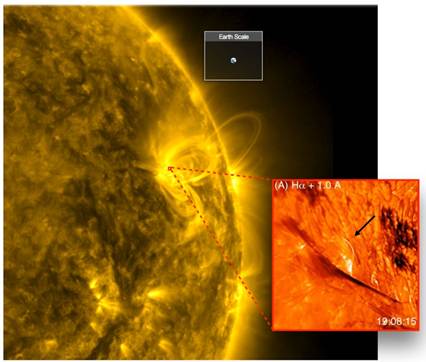Tiny loops in Solar Corona can unveil Sun’s hidden explosive secrets
Tiny loops in Solar Corona can unveil Sun’s hidden explosive secrets
A new breakthrough from astronomers reveals a dazzling world of miniature plasma loops in the lower layers of the Sun’s atmosphere. These are so small and short-lived, that they have stayed hidden until now. However, they hold clues to one of the Sun’s deepest mysteries –how it stores and unleashes magnetic energy.
While the Sun may appear calm to our eyes, beyond the glowing surface of the Sun lies a much less dense yet highly dynamic atmosphere made of plasma and shaped by magnetic fields.
Among the most intriguing features of the Sun’s outer layer are coronal loops, arc-like beautiful structures of hot plasma that glow at a temperature over a million degrees.
While these large loops in the solar corona, or outer atmosphere, have long been studied, scientists are now also paying attention to miniature counterparts of these loops.
These miniature loops are about 3,000–4,000 kilometers long (roughly the distance from Kashmir to Kanyakumari). However, they have a width of less than 100 kilometers. This makes them challenging to study, as they stay hidden in the lower layers of the Sun’s atmosphere and are mostly unresolved by earlier telescopes.
Astronomers at the Indian Institute of Astrophysics (IIA), an autonomous institution of the Department of Science and Technology (DST) and their collaborators used high-resolution imaging and spectroscopy to catch these elusive structures in action.

Fig: Hα blue wing image showing a tiny loop (the elongated bright feature pointed by a black arrow). The background image is taken in extreme-UV with the NASA’s SDO satellite, showing large solar coronal loops. Data courtesy: SDO/AIA and BBSO/GST.
“These tiny loops live fast – and die young, lasting only a few minutes, making it extremely difficult to observe them and interpret their physical origins. Although they are small, these loops punch above their weight when it comes to understanding the Sun. They offer a new window into how magnetic energy is stored and released in the solar atmosphere on small scales”, said Annu Bura, a Ph.D. student at IIA and the first author of the paper published on this result.
The team used a combination of cutting-edge telescopes to investigate these small-scale coronal loops. They combined data from the Goode Solar Telescope at BBSO, NASA’s Interface Region Imaging Spectrograph (IRIS) and the Solar Dynamics Observatory (SDO) to explore these loops across multiple wavelengths. Annu Bura added, “Our multi-instrument observation allowed us to analyze the loops not only in visible light but also in ultraviolet and extreme-ultraviolet wavelength, revealing their behavior across the chromosphere, transition region and corona, the different layers of the Sun’s atmosphere.”
The H-alpha spectral line from Hydrogen atoms is a key line for probing the solar chromosphere which is just above the visible surface of the Sun. The team found that in the redder or longer wavelength part of this line, these loops appear as bright, delicate arcs similar to coronal loops and these were seen very clearly for the first time.
“We detected enormous broadening of the width of the spectral line and intensified signals in spectral lines using IRIS spectroscopic data, indicating highly non-thermal processes due to magnetic fields associated with their origin. This observation can be interpreted as a complex plasma process called magnetic reconnection, in which tangled magnetic field lines snap and realign, unleashing bursts of energy, said Tanmoy Samanta, a faculty member at IIA and a co-author of the study.
“We observed plasma jets erupting upward from the tops of these loops. These jets seem to share the same origin as the loops, suggesting they are both triggered by the same explosive reconnection event”, said Tanmoy Samanta. In fact, their formation echoes that of bigger jets in the solar corona, possibly driven by the eruption of tiny, nearly invisible solar filaments.
To understand the plasma temperature inside these loops, the team used an advanced technique called Differential Emission Measure analysis. The results showed plasma temperatures soaring above several million degrees —hot enough to shine in the extreme ultraviolet, visible in SDO’s Atmospheric Imaging Assembly. “This behavior is puzzling as the loops have a height of around 1 million metres and lie within the chromosphere, where plasma densities are much higher than the corona. It is quite difficult to heat the plasma to such a hot temperature”, said Jayant Joshi, a faculty member at IIA. He added, “future spectroscopic observation can help us to understand this puzzling behavior.”
Looking ahead, future telescopes with even sharper chromospheric imagers and more sensitive magnetic field measurements—such as India’s proposed 2-meter aperture National Large Solar Telescope (NLST), planned near Pangong Lake in Ladakh—could help unlock even more secrets hidden within these small-scale solar features. The study is published in The Astrophysical Journal.
The study on this fundamental astrophysical topic of magnetized plasma loops was carried out by an international team led by Annu Bura, Tanmoy Samanta, Jayant Joshi from IIA and collaborators from NASA, the Max Planck Institute for Solar System Research (MPS) in Germany and the Big Bear Solar Observatory (BBSO) in USA.